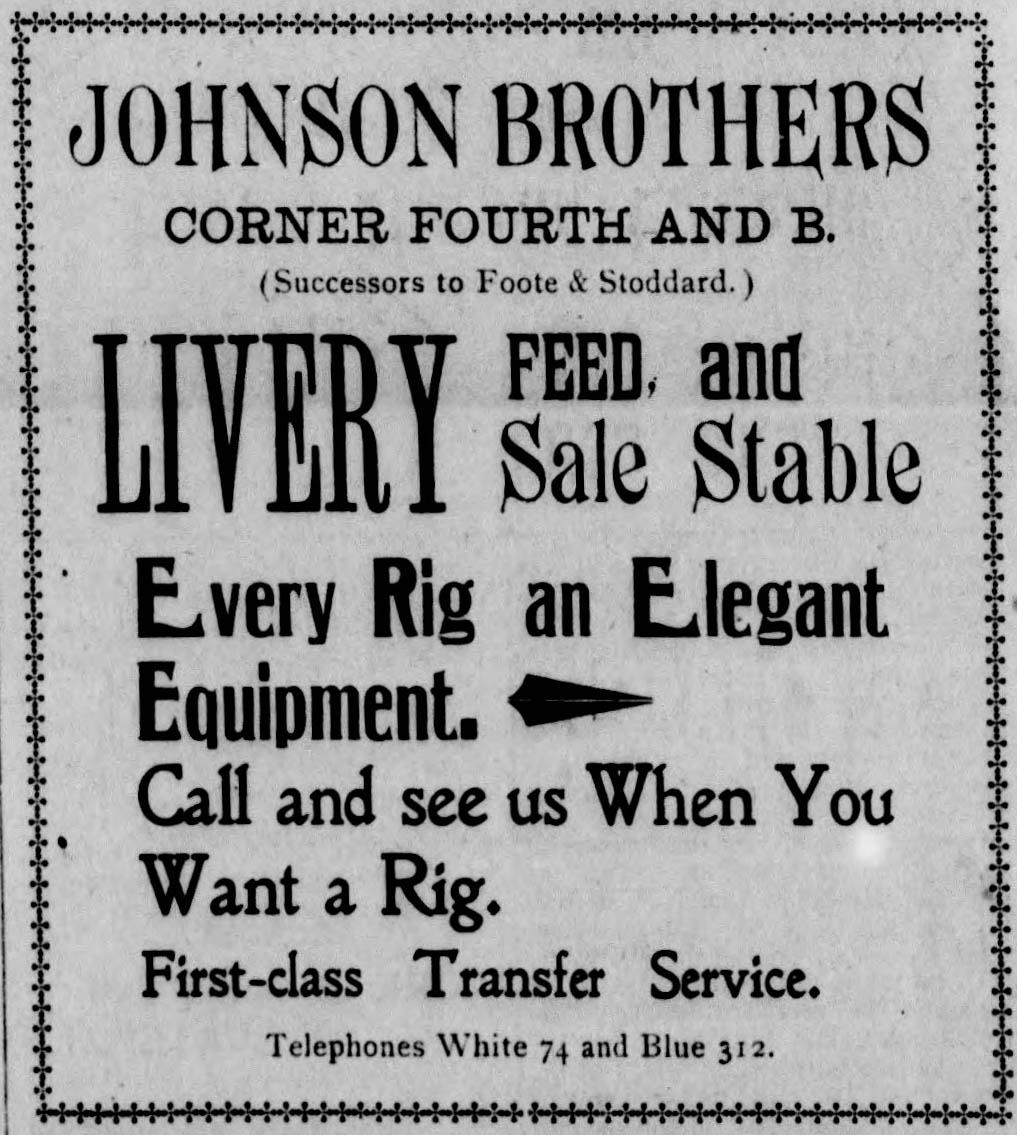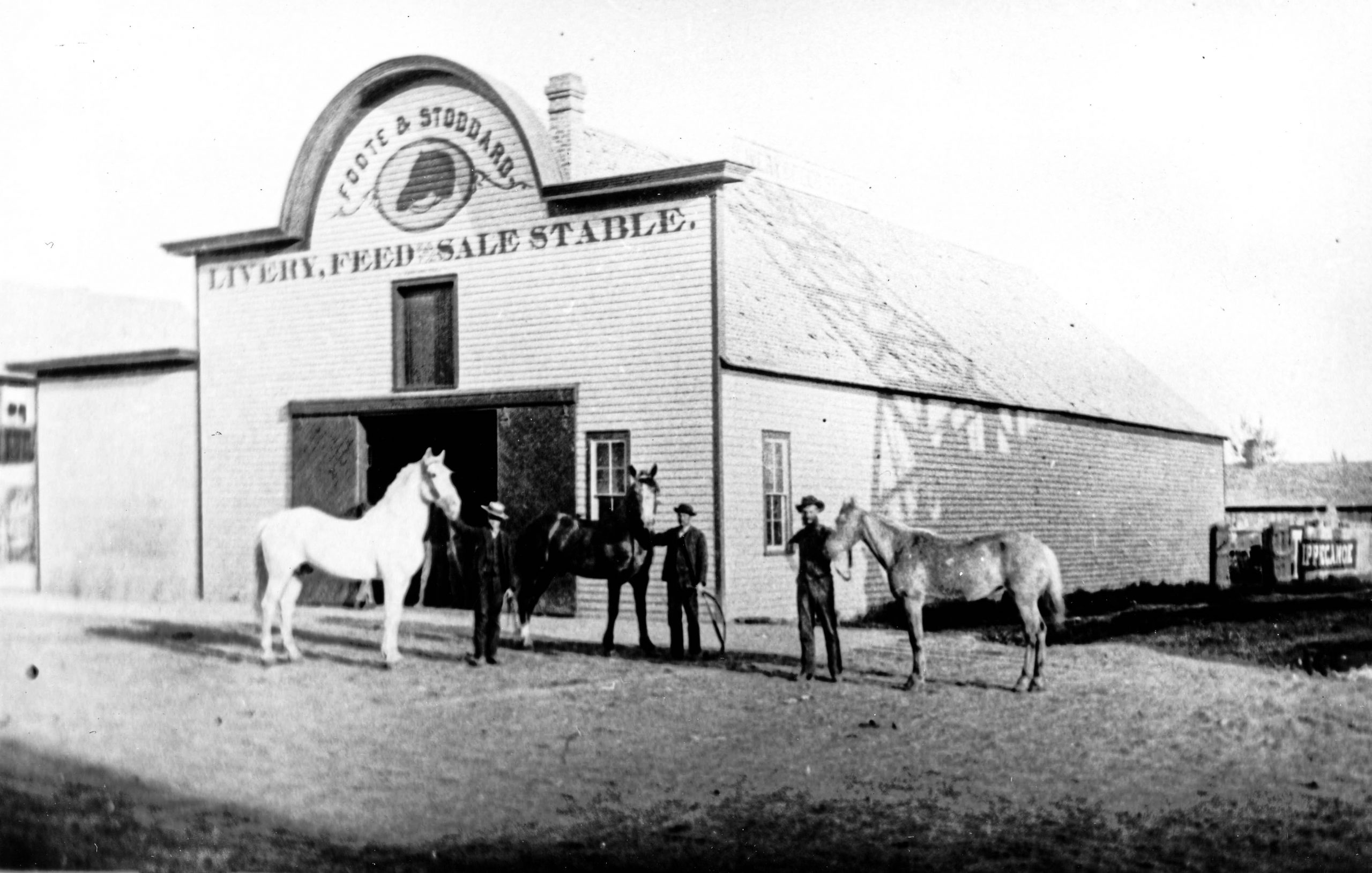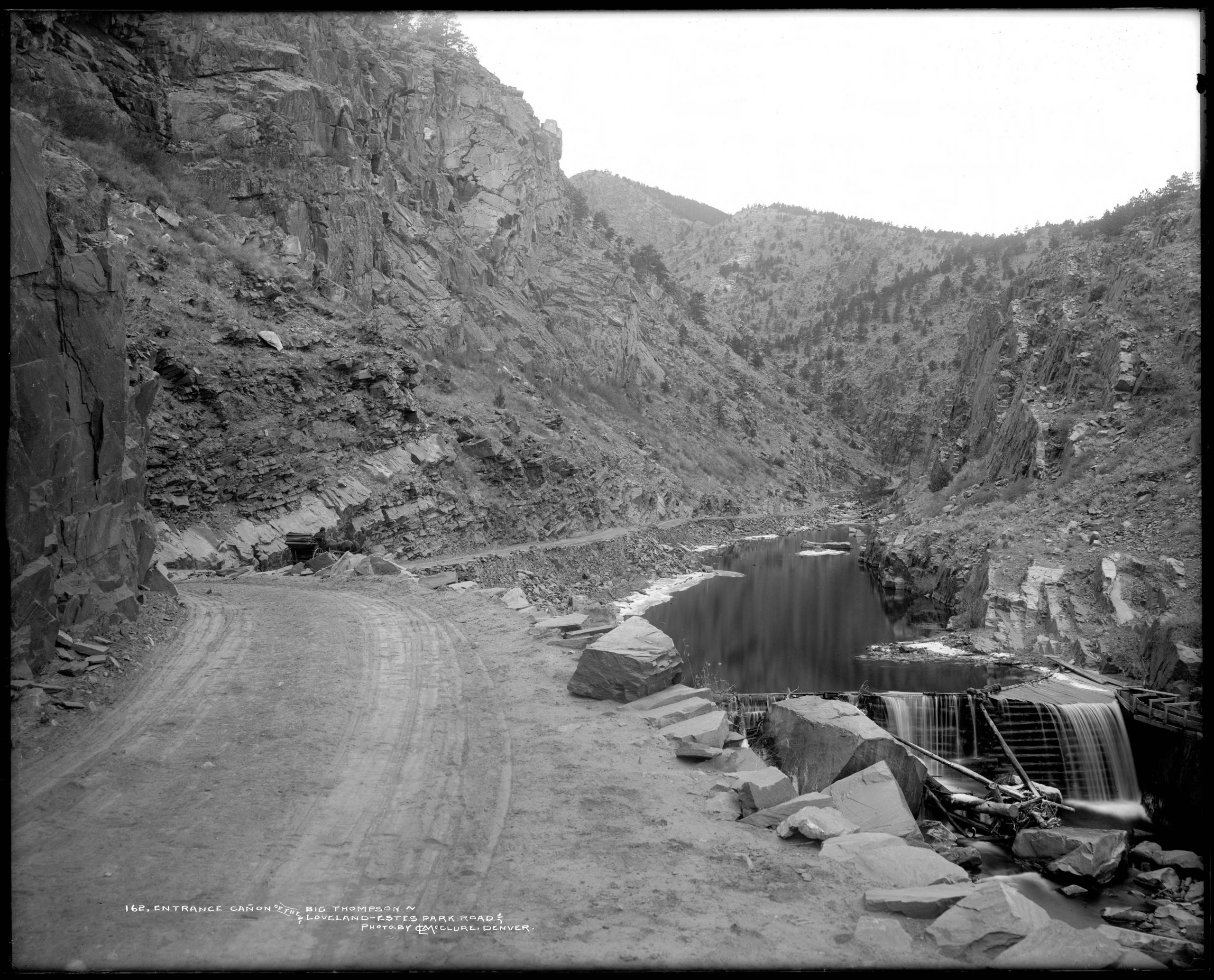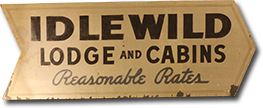The completion of the Riley Road in 1903 marked the beginnings of a tourist boom in the Big Thompson Canyon. For the first time a road went through the narrows, which would allow travelers to bypass miles of mountainous toll road on a trip to Estes Park. Loveland was quickly becoming known as the new “Gateway to Estes Park.”1Loveland Register, 4 Feb. 1904. Colorado Historic Newspapers Collection. Colorado State Library.
The previous year the Colorado and Southern Railway (C. & S.) had opened a new depot in Loveland and since then were continually looking for ways to attract passengers.2Lee Morrow (January 25, 1980). “National Register of Historic Places Inventory/Nomination: Colorado and Southern Railway Depot / Loveland Depot”. National Park Service. Retrieved June 1, 2021. With the opening of the Riley Road they saw an opportunity to combine their railway with a stage line, to create a new fast route into into the Park.

The Colorado and Southern Railway depot in Loveland c. 1910.3“Loveland Depot.” Denver Public Library: Digital Collections. 2021. 13 Dec 2021.

Closeup of the C. & S. Railway Depot located at the corner of 5th Street and Railroad Avenue.4“Loveland Depot.” Fort Collins History Connection: An Online Collaboration of the Fort Collins Museum and the Poudre River Public Library District. 2021. 12 Dec 2021.
At the time, a number of stage companies were already established in Loveland, the most prominent being the Johnson Brothers Livery.

First advertisement for the Johnson Brothers Livery put out shortly after the Johnson Brothers acquired the Foote & Stoddard Livery.5Loveland Register, 7 May. 1903. Colorado Historic Newspapers Collection. Colorado State Library.
George W. Johnson and his younger brother Benjamin B. Johnson started their horse and carriage business in 1903.6Loveland Register, 7 May. 1903. Colorado Historic Newspapers Collection. Colorado State Library. Earlier that year they had purchased the liveries of Jim Coulter and Foot-Stoddard and combined them to form the Johnson Brothers Livery.7Loveland Register, 11 Mar. 1903. Colorado Historic Newspapers Collection. Colorado State Library.8Loveland Register, 22 Apr. 1903. Colorado Historic Newspapers Collection. Colorado State Library. C. & S. officials approached the Johnson brothers in 1904 to market a daily stage coach to and from the Park.

Foote and Stoddard Livery before being purchased by the Johnson Brothers. The livery was located on 4th street one block away from the C. & S. Railway Depot.9“Foote and Stoddard Livery.” Denver Public Library: Digital Collections. 2021. 13 Dec 2021.

Foote and Stoddard Livery in 1901 two years before being purchased by the Johnson Brothers. The livery is located on the left side of the photo, while the Bartholf Opera house is situated across to the right.10“Foote and Stoddard Livery.” Denver Public Library: Digital Collections. 2021. 13 Dec 2021.
The plan was for the Johnson Brothers to run a daily stage coach from May to October that would depart directly from the C. & S. train-station and arrive in Estes Park by the evening.11Loveland Register, 30 Nov. 1904. Colorado Historic Newspapers Collection. Colorado State Library. A returning stage coach would run the opposite direction at the same time. Tickets would cost $6.60, or about $200 in today’s dollars.12Loveland Register, 30 Nov. 1904. Colorado Historic Newspapers Collection. Colorado State Library. The C. & S. Railway would in turn provide free advertising for the Johnson Brothers. They initially hired a professional photographer to take photos of the Big Thompson Canyon, which were used in advertisements and flyers handed out by C. & S. representatives.13Loveland Register, 30 Nov. 1904. Colorado Historic Newspapers Collection. Colorado State Library.
Stage Coach To Estes Park Resorts
Will Increase Travel Here
Colorado & Southern Arrange for Daily Stage to Estes Park via New Road – Johnson Brothers In Deal – Will be Advertised
Travel to Estes Park during the season of 1905 will be largely through Loveland via the Loveland-Estes Park scenic road. So much has been assured by the recent action of the Colorado & Southern officials closing a contract with Johnson Brothers livery of this city, calling for a daily stage coach each way from Loveland and Estes Park, from May 15 until the last of October. Johnson Bros. agree to arrange a relay at The Forks and will make the time into the Park much shorter than by any previous route.
Traveling Passenger Agent Church for the C. & S. last week made a trip to the Park with the railroad’s official photographer and a number of fine views were taken of the different canons. These will be converted into plates and the Loveland-Estes Park road will be widely advertised throughout Colorado and the East where it is certain to do much good.
The officials of the railroad are enthusiastic over the prospects for a largely increased traffic to Colorado’s most beautiful summer resort. The Burlington rate via the Lyons road has been $6.60 and this will be met by the C. & S. meaning that those who desire to travel by far one of the most scenic roads in Colorado, will take advantage of the Loveland route. Two handsome new stage coaches have been ordered, each with a capacity of twelve person. The usual allowance for baggage will be made and this will require a baggage wagon placed on in connection.
Mr. Church made the following statement to a representative of The Register yesterday.
“Its is quite true that the Colorado & Southern road will make a strong effort to handle the major part of the Estes Park travel next year, and I believe with the present contemplated, in fact already assured arrangements, that we will do a large business through Loveland. Our contract with Johnson Brothers of Loveland will enable us to reach the Park ahead of the Burlington-Lyons road route. Besides I believe the Loveland-Estes Park road to be one of the prettiest things in all Colorado and this will appeal to many who are in the habit of spending their summers in Estes Park.
“We intend to advertise the road extensively, give the patrons something new, and I am sure our efforts will be well repaid. This means a good thing for your town, too. It will help advertise it and will bring a large number of tourists there each year.”
Chairman Munson informs us that there will be considerable improvement on the road during the coming winter and everything possible to aid a growing popularity for the Loveland-Estes Park road will be done. It has been suggested that a rail be built along the road in the parts where it is closest to the river, and it may be that this will be done.14Loveland Register, 30 Nov. 1904. Colorado Historic Newspapers Collection. Colorado State Library.
The Loveland Register – November 30, 1904
In preparation for the stage line the Johnson Brothers built a relay station about midway on the proposed route, at a place known as the “The Forks”, today known as Drake.15Loveland Register, 30 Nov. 1904. Colorado Historic Newspapers Collection. Colorado State Library. This building would be used to exchange exhausted horses with rested ones halfway through the trip. They also purchased two new four-horse carriages and began training twenty-five horses.16Loveland Register, 30 Nov. 1904. Colorado Historic Newspapers Collection. Colorado State Library.17Loveland Register, 12 Apr. 1905. Colorado Historic Newspapers Collection. Colorado State Library.
The Johnson Brothers inaugurated the new stage-line on May 15, 1905.18Loveland Register, 15 May. 1904. Colorado Historic Newspapers Collection. Colorado State Library.
BIG THOMPSON ROUTE TO THE GREAT RESORT
Johnson Brothers Inaugurate Daily Stage Service Between Loveland and Estes Park P.O.
May 15th the first stage of Johnson Brothers’ line, drawn by four good horses left the Colorado & Southern railway station on arrival of the morning train, for accommodation of passengers to Estes Park.
Johnson Brothers deserve much credit for their liberality in equipping this stage line. The wagons are new and of the latest pattern, especiallly designed for the comfort of the passenger.
The route of the line is over the new and splendid country road, along the Big Thompson river. The canon of the Big Thompson is unsurpassed for magnificent scenery, and the end of the journey is crowned by the grandest view of them all – Estes Park – a panorama beyond description.
A splendid eating station is to be maintained at the half way house by F. G. Bartholf. Here a stop of thirty minutes will be made for dinner and change of horses.
Estes Park affords so many attractive summer hotels, such fine fishing and hunting, and alluring roads for riding and driving, that its popularity for summer outings is increasing from year to year, especially as the facilities for reaching it are improved.
The same one way and round trip rates apply via the Colorado & Southern railway and Loveland as have applied by way of Lyons, and the indications are that the larger part of the season’s travel to and from Estes Park will be through Loveland.
The Colorado & Southern railway has issued a nicely illustrated publication descriptive of Estes Park and its tourist accommodation.19Loveland Register, 17 May. 1905. Colorado Historic Newspapers Collection. Colorado State Library.
The Loveland Register – May 17, 1905
Initially the brothers only planned on transporting twelve people a day one way, the capacity of one of their carriages. However demand was much higher than anticipated and two additional stage coaches were added to the fleet.20Loveland Register, 5 Jul. 1905. Colorado Historic Newspapers Collection. Colorado State Library.21Loveland Register, 19 Jul. 1905. Colorado Historic Newspapers Collection. Colorado State Library. On some days they were transporting up to twenty-five passengers one way. By the end of the 1905 season the brothers declared the stage line a success.22Loveland Register, 26 Jul. 1905. Colorado Historic Newspapers Collection. Colorado State Library.



Advertisements for the Loveland-Estes Park Stage Line during the 1905 opening year.23Loveland Register, 10 May. 1905. Colorado Historic Newspapers Collection. Colorado State Library.24Loveland Register, 14 Jun. 1905. Colorado Historic Newspapers Collection. Colorado State Library.25Loveland Register, 5 Jul. 1905. Colorado Historic Newspapers Collection. Colorado State Library.
With such good business the opening year the Johnson Brothers announced they would continue running the stage-line. Operations would restart on May 15, 1906.26Loveland Register, 23 May. 1906. Colorado Historic Newspapers Collection. Colorado State Library.
During the 1905 season Frank Bartholf, who owned the Forks Hotel, had began serving food to guests waiting at the stage-line relay station. Travelers had a thirty minute stop to grab a quick breakfast or dinner while the stage coach horses were being switched out. During the 1906 season other places in the canyon began following suite by offering hot meals to travelers en-route. The Montrose Inn at Cedar Cove became “a popular place for the stage coach to stop for regular dinners.”27Drake Home Demonstration Club, “History of the Big Thompson Canyon” 1939. p3 Frank Bartholf’s daughter, Ella Van Bramer, who had been preparing the meals at the Forks Hotel, opened Idlewild this summer, and it became a secondary relay station for the stage-line.28Neville, Frend. (1971). Marvin Flats. Harold M. Dunning (Author), Over Hill and Vale; In The Evening Shadows of Colorado’s Longs Peak. Boulder, CO: Johnson Publishing Company. Hot meals were also available here, for travelers awaiting a horse change.29Loveland Register, 21 Jun. 1906. Colorado Historic Newspapers Collection. Colorado State Library.

Advertisement for the Loveland-Estes Park Stage Line during the 1906 season.30Loveland Register, 17 May. 1906. Colorado Historic Newspapers Collection. Colorado State Library. The advertisement shows that trips to Estes Park took 6 hours and 50 minutes, while return trips to Loveland would take 3 hours and 30 minutes.
That June heavy rains washed out the roadway making travel up the Big Thompson extremely difficult. Abner Sprague was a traveler during that time and recalls his experience:
“I remember well the last trip I made by stage. It was from Loveland over the canon road which at that time was narrow and rough at best, Johnson Brothers – Geo. W. and B. B. owners. The trip was made during the high water in June the last year a horse drawn stage was operated. I remember our driver was Geo. W. Johnson, now a contractor in the Park. Among the passengers were two lively girls on the high seat with the driver; inside were Dr. and Mrs. Wood bound for the Elkhorn Lodge, Mrs. Sprague and myself, and others to fill the rig. A lead horse ready saddled, brought up the rear. We met the down stage in the foothills, and was advise to turn back, as the water was over the road in many places and washing badly. Mr. Johnson decided to turn back when we could find no road bed to travel over. Water was over the road in many places through the big canon, but the first place to cause a halt and examination was in Louie Canon. There the water was raging through from wall to wall, with no sign of a road bed, but a bend in the stream threw the force of the water away from the roadside. So through we went, Johnson keeping a lookout for any swirl in the stream that would indicate a washout. All the way up to Waltonia there was water running over the road in all low places. Just above the Waltonia bridge the roadbed was low at that time, and the water coming around the bend swept full force against and over the pace where the road should be, making it look like the deepest part of the river. Here was where the saddle horse could pay for his passage. It was thought best to ride through and find out if there was road enough left to drive over. As I was the son of a sailor and the only man available for the job, it was up to me.
I mounted the horse, but just before starting Mrs. Sprague called to me to give her the Kodak, which I had over my shoulder, like all tourists. I told her that was thoughtful, for there was no use in losing me and the camera, both. But the idea was a good one, for if I had tumbled in the swift stream it would not have been handy around my neck. Before entering the water was once I made plans ahead as to what I would do. If the horse should be swept into that raging stream, taking me with him, the first thing to do would be to get away form the horse as soon as possible; then I would use no effort more than enough to ride as near the surface of the water as I could, like a log, and wait to be washed near a bank lined with brush at some bend in the stream.
As the stream side of the road would be the one to go first, I kept the pony in the track. For nearly half the distance I could see the rocky road, then for several feet nothing but rushing water. I drew my feet from the stirrups and urged the horse on; when he stepped into the deeper water it came up to his body. He stepped on a large rock which sloped toward the creek, slipped and nearly went down, but recovered and we went safely through
As they could not hear me for the rushing water, I gave the sign to come on. That was when I wished I had hung to the camera. Nothing was left on the roadbed but the larger rock. The fine material having been washed away. George had the lines to hang to, but those girls only had each other and the high seat when the stage swayed and bumped over the large rock. When the near lead horse stepped into the deep place he slipped on the sloping rock and went down, the water dashing over him. What a snap shot if only the expression on those girls’ faces could have been shown. Johnson held the team to the road, the leader recovered his feet at once, and they came on through. The girls looked dizzy and seasick; inside all was well as they had something to hang onto with both hands. We had no further trouble and arrived on time.”31The Estes Park Trail, 10 Feb. 1928. Colorado Historic Newspapers Collection. Colorado State Library.
Abner E. Sprague
Estes Park Trail, February 10th, 1928
The road washout was fixed within a week and the Johnson Brothers would have another good year with plenty of passengers.32Loveland Register, 21 Jun. 1906. Colorado Historic Newspapers Collection. Colorado State Library.33Loveland Register, 12 Jul. 1906. Colorado Historic Newspapers Collection. Colorado State Library. Despite high demand and support from the community of Estes Park, the Johnson Brothers would exit the stage-line business at the end of 1906 season.34Loveland Register, 27 Jun. 1906. Colorado Historic Newspapers Collection. Colorado State Library.35Loveland Register, 6 Mar. 1907. Colorado Historic Newspapers Collection. Colorado State Library.

A horse and buggy enters the Big Thompson Canyon c. 1907 one season after the Johnson Brothers stopped their stage line.36“Entrance Canon of the Big Thompson.” Denver Public Library: Digital Collections. 2021. 13 Dec 2021.
- Loveland Register, 4 Feb. 1904. Colorado Historic Newspapers Collection. Colorado State Library.
- Lee Morrow (January 25, 1980). "National Register of Historic Places Inventory/Nomination: Colorado and Southern Railway Depot / Loveland Depot". National Park Service. Retrieved June 1, 2021.
- “Loveland Depot.” Denver Public Library: Digital Collections. 2021. 13 Dec 2021.
- “Loveland Depot.” Fort Collins History Connection: An Online Collaboration of the Fort Collins Museum and the Poudre River Public Library District. 2021. 12 Dec 2021.
- Loveland Register, 7 May. 1903. Colorado Historic Newspapers Collection. Colorado State Library.
- Loveland Register, 11 Mar. 1903. Colorado Historic Newspapers Collection. Colorado State Library.
- Loveland Register, 22 Apr. 1903. Colorado Historic Newspapers Collection. Colorado State Library.
- “Foote and Stoddard Livery.” Denver Public Library: Digital Collections. 2021. 13 Dec 2021.
- “Foote and Stoddard Livery.” Denver Public Library: Digital Collections. 2021. 13 Dec 2021.
- Loveland Register, 30 Nov. 1904. Colorado Historic Newspapers Collection. Colorado State Library.
- Loveland Register, 12 Apr. 1905. Colorado Historic Newspapers Collection. Colorado State Library.
- Loveland Register, 15 May. 1904. Colorado Historic Newspapers Collection. Colorado State Library.
- Loveland Register, 5 Jul. 1905. Colorado Historic Newspapers Collection. Colorado State Library.
- Loveland Register, 19 Jul. 1905. Colorado Historic Newspapers Collection. Colorado State Library.
- Loveland Register, 10 May. 1905. Colorado Historic Newspapers Collection. Colorado State Library.
- Loveland Register, 14 Jun. 1905. Colorado Historic Newspapers Collection. Colorado State Library.
- Loveland Register, 23 May. 1906. Colorado Historic Newspapers Collection. Colorado State Library.
- Drake Home Demonstration Club, “History of the Big Thompson Canyon” 1939. p3
- Neville, Frend. (1971). Marvin Flats. Harold M. Dunning (Author), Over Hill and Vale; In The Evening Shadows of Colorado’s Longs Peak. Boulder, CO: Johnson Publishing Company.
- Loveland Register, 21 Jun. 1906. Colorado Historic Newspapers Collection. Colorado State Library.
- Loveland Register, 17 May. 1906. Colorado Historic Newspapers Collection. Colorado State Library.
- The Estes Park Trail, 10 Feb. 1928. Colorado Historic Newspapers Collection. Colorado State Library.
- Loveland Register, 21 Jun. 1906. Colorado Historic Newspapers Collection. Colorado State Library.
- Loveland Register, 12 Jul. 1906. Colorado Historic Newspapers Collection. Colorado State Library.
- Loveland Register, 27 Jun. 1906. Colorado Historic Newspapers Collection. Colorado State Library.
- Loveland Register, 6 Mar. 1907. Colorado Historic Newspapers Collection. Colorado State Library.
- “Entrance Canon of the Big Thompson.” Denver Public Library: Digital Collections. 2021. 13 Dec 2021.


![Idlewild Lodge - idlewildlodge.github.io - 1905-05-17 - The Loveland Register - Johnson Brothers inaugurate stage coach to Estes Park [2 Articles]](https://idlewildlodge.github.io/wp-content/uploads/Post-Stage-Line-To-Idlewild-Article-1905-05-17-The-Loveland-Register-Johnson-Brothers-inaugurate-stage-coach-to-Estes-Park-2-Articles.jpg)